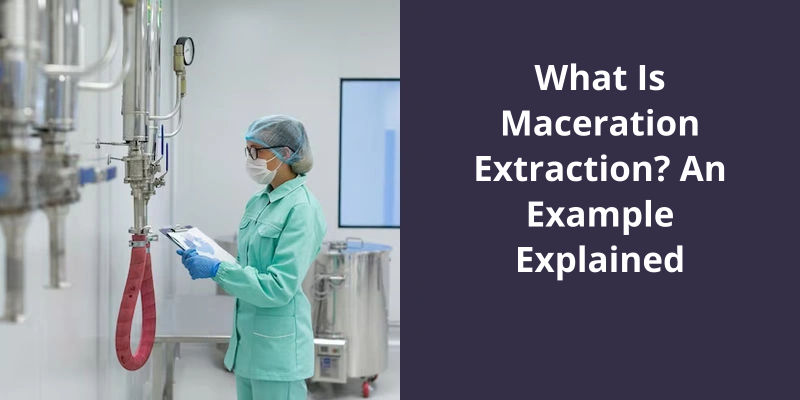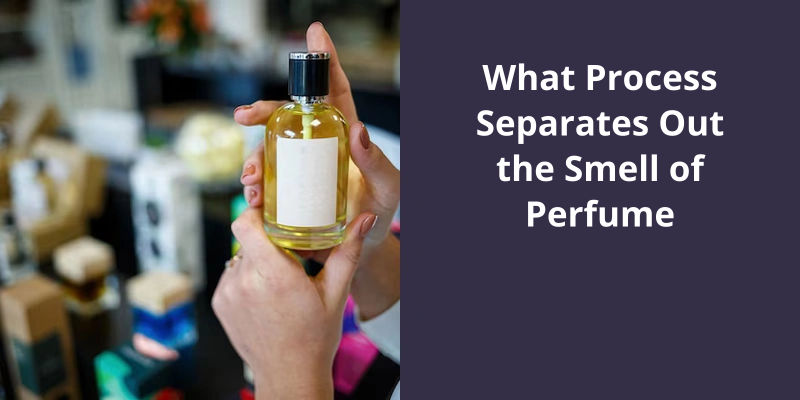Maceration Extraction is a simple method used to extract compounds from plants. It involves soaking plant materials in a liquid, typically water, alcohol, or other solvents, to break down the plant’s cell walls and release its active ingredients. This process, which may take a few hours to several weeks, is often carried out at room temperature. The liquid absorbing the plant’s essence is known as a macerate. After straining out the solid plant parts, the remaining liquid contains the extracted compounds. This method is commonly used in the production of essential oils, herbal remedies, and certain types of alcoholic beverages.

What Is the Difference Between Maceration and Percolation Extraction?
When it comes to extracting compounds from plant material, there are several methods available. Two of the most commonly used techniques are maceration extraction and percolation extraction. While both methods are effective at extracting the desired compounds, there are some key differences between the two.
Maceration extraction involves soaking the plant material in a solvent, typically a high-proof alcohol, for a set period of time. During this time, the solvent extracts the desired compounds from the plant material. This process is relatively simple and requires only a few basic pieces of equipment. Additionally, maceration extraction can be repeated fairly easily on a consistent basis, making it a popular choice for many applications.
Percolation extraction is a more involved process that requires additional equipment and typically more solvent than maceration extraction. With percolation extraction, the plant material is packed into a column and the solvent is slowly passed through it. This process is often used for large-scale extractions, as it allows for a high volume of material to be processed in a relatively short amount of time.
This is because the solvent is able to more thoroughly penetrate the plant material during the percolation process, resulting in a higher yield of desired compounds.
This can make it a less cost-effective option for smaller-scale extractions. Additionally, percolation extraction can be more difficult to repeat consistently, as there are more variables involved in the process.
Differences in the Types of Solvents Used for Maceration and Percolation Extraction
- For maceration extraction, solvents like ethanol, methanol, and water are typically used.
- For percolation extraction, solvents like hexane, benzene, and chloroform are usually utilized.
- Maceration extraction is a simple soaking process that allows for the solvent to extract the desired compounds from the plant material.
- Percolation extraction involves passing a solvent through a bed of plant material to extract the desired compounds, making it a more efficient method.
- Maceration extraction is more commonly used for smaller scale extractions, while percolation extraction is typically used for larger scale extractions.
- The choice of solvent for each extraction method depends on the specific plants being used, as well as the desired end product.
Now that we’ve discussed what multiple maceration is, it’s important to understand the different types of this process. There are two main types of multiple maceration: double maceration and triple maceration. Each type has it’s own unique characteristics and benefits, which we will explore further in the next section.
What Is Multiple Maceration?
Multiple maceration is a common and widely used process in the preparation of concentrated extracts. It’s essentially a process where botanical material is continuously extracted in multiple batches, thereby yielding highly concentrated extracts.
This process ensures maximum extraction of all the active constituents of the botanicals. The resulting extracts are rich in active ingredients and are highly concentrated.
The resultant extracts are traditionally used in the treatment of a range of ailments, including skin disorders, respiratory issues, and digestive disorders, among others.
In addition to the extraction method, the type of plant material used also plays a crucial role in determining the quality and potency of the extract. Freshly harvested plants are usually more potent than dried ones. Moreover, the timing of the harvest, the soil type, and climatic conditions also affects the quality of the final extract.
The processes includes a double maceration and triple maceration.
Comparison Between Multiple Maceration and Other Extraction Methods (Such as Solvent Extraction, Cold-Pressing, Etc.)
This article compares the effectiveness of multiple maceration with other extraction methods like solvent extraction and cold-pressing.
When it comes to extracting compounds from natural materials, there are a variety of methods available. However, not all methods are created equal; some are more complex than others, while others are quicker or more efficient. One of the simplest extraction methods available is maceration, which can be useful for extracting certain types of compounds, particularly those that are sensitive to heat. Nonetheless, there are some drawbacks to this method that should be taken into consideration.
What Is the Simplest Extraction Method?
Maceration is an age-old extraction method that’s been used for centuries to isolate bioactive compounds from plants. The technique involves soaking the plant material in a solvent for an extended period of time. The solvent used can be any liquid that’s capable of dissolving the compound of interest. The most commonly used solvents are water, alcohol, and oil.
Another disadvantage of maceration is it’s low extraction efficiency. Not all of the compounds in the plant material will be extracted using this method. Some compounds aren’t soluble in the solvent used and won’t be extracted. Other compounds may be destroyed or degraded by the prolonged exposure to the solvent.
It’s commonly used to extract thermolabile compounds that are easily degraded by heat. Since maceration is performed at room temperature, it doesn’t expose the plant material to high temperatures that could alter the composition of the extract.
Some plants are too fragile to withstand the harsh conditions required for other extraction methods such as steam distillation or Soxhlet extraction.
What Are Other Common Extraction Methods Used in the Industry and How Do They Compare to Maceration in Terms of Efficiency and Cost?
There are several other extraction methods commonly used in the industry, including solvent extraction, steam distillation, and supercritical CO2 extraction. Each method has it’s own advantages and disadvantages in terms of efficiency and cost. While maceration is a traditional and relatively inexpensive method, other techniques can provide higher yields and more precise extraction of specific compounds. However, these methods may also require more specialized equipment and higher costs, making them less accessible to some producers.
Source: Techniques for extraction and isolation of natural products
Now that we understand what maceration is and some of it’s applications, let’s explore the various methods of maceration and their benefits.
What Is Maceration and Examples?
In the food industry, maceration is used to extract flavor and nutrients from fruits, vegetables, and herbs. This process involves soaking the ingredients in a liquid, often alcohol or water, to soften and break down the cell walls, allowing for easier extraction. The resulting mixture can be used as a base for sauces, marinades, and dressings, or as a flavoring agent in baked goods and confections.
One popular example of maceration is the process used to make fruit jams and preserves. In this process, fruit is combined with sugar and allowed to sit for an extended period of time to draw out the natural juices and flavors. The mixture is then cooked and processed to create the thick, spreadable jam that we all know and love.
Another example is the use of maceration in the production of wine. In this process, grapes are crushed and allowed to soak in their own juices for an extended period, allowing the skins, seeds, and stems to release their flavor and tannins. The resulting mixture, known as must, is then fermented to create wine.
Maceration is also a common technique used in the production of essential oils. In this process, plant material is soaked in a carrier oil, such as almond or olive oil, to extract the essential oils. The resulting mixture is then distilled to separate the oil from the carrier oil, creating a pure and potent essential oil.
In the medical field, maceration is used to remove dead or damaged tissue from wounds. This process involves soaking the affected area in a solution of water and enzymes, which break down the tissue, allowing for easier removal.
From food and beverage production to medicine and cosmetics, maceration plays an important role in many aspects of our daily lives.
Different Types of Maceration Techniques and How They Vary in the Process and Result.
This topic explores the various techniques used in maceration and how they differ in terms of their process and resulting products.
As a culinary technique, macerating adds both flavor and texture to the fruit. It can be used to infuse fruits with a variety of flavors, from herbs and spices to sweeteners and alcoholic beverages. But maceration isn’t just limited to the food industry- it’s also a common practice in the wine-making process, where grape skins and juices are soaked together to extract tannins and color. So, whether you’re a chef or a winemaker, understanding the intricacies of maceration is key to creating a delicious end product.
What Is Maceration in Food Processing?
As the fruit soaks in the liquid, it releases it’s natural juices and flavors, which mix with the added liquid to create a unique taste. The maceration process softens the fruit, making it easier to eat and improving it’s texture. Furthermore, the process can be used to preserve fruits that might otherwise spoil quickly.
Some people prefer to use fresh fruits, while others prefer to use dried fruits. Some popular liquids for maceration include red wine, brandy, and sugar syrup. The amount of time that the fruit is left to macerate depends on the desired result. Some recipes call for just a few hours of maceration, while others recommend leaving the fruit to soak overnight.
Macerating is a common technique used in the baking industry, particularly in creating fruit pies and tarts. By macerating the fruit beforehand, bakers can ensure that the fruit will be tender and juicy when it goes into the pie or tart. Maceration can also be used to create dessert toppings, such as ice cream and sorbets. The fruit can be strained before being used, and the resulting liquid can be used to create a flavorful sauce or syrup.
With it’s simplicity and adaptability, maceration is sure to become a favorite technique among home cooks and professional chefs alike.
Different Methods of Maceration in Food Processing (e.g. Cold Maceration vs. Warm Maceration)
- Cold maceration
- Warm maceration
- Enzymatic maceration
- Vacuum maceration
- Rotary drum maceration
- Pressurized liquid extraction
- Ultrasound-assisted maceration
Conclusion
This technique is widely used in pharmaceuticals and cosmetics industries for the production of herbal products, natural remedies, and cosmetics. By choosing a specific menstruum and adjusting the process conditions, researchers can successfully extract and isolate a wide range of phytochemicals with various therapeutic benefits.





